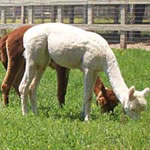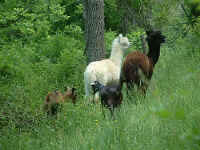|
About Alpacas>Habit |
|
Alpacas are ruminant herbivores, which is to say that they eat vegetation and chew the cud. They are both grazers and browsers: their preference is for good quality short grass, which they nibble gently (which enables rapid regrowth), but will happily strip within-reach branches of their flowers and leaves. They are excellent converters of energy: their three-compartment stomach is digestively around 30% more efficient than sheep. Alpacas are very hardy and adapt well to a range of climates and pastures.
During winter, those with lower needs may survive solely on good quality hay but those with a higher nutritional requirement (pregnant or lactating females, for example) will need some form of supplementary feeding (see Needs). |
|
 |
|
| |
Alpacas have soft pads (not hoofs) and are very gentle on the pasture causing poaching only on the softest of ground and in any case much less so than sheep. For the technically minded the alpaca foot pressure is 39kPA, compared to sheep at 82kPA, and cattle 185kPA.. Alpacas create ‘latrines’: a few selected small areas that the herd uses for defaecation and urination. This results in very clean paddocks, little spoiled grazing and easier parasite control. These do need managing however to ensure they don’t get too large (alpacas will not graze the vicinity of the dung pile), but provide excellent manure which may be sold. When moving alpacas into a new paddock you can establish the latrines in positions convenient to you: just place a couple of shovelfuls of dung on the ground and they’ll take the hint. |
|
| |
Communication amongst the herd is predominantly via soft humming sounds and body language (flattened ears, raised neck and tail). Alpacas have excellent eyesight and will spot danger at over a kilometre. If there is a perceived danger, a stray dog for example, a series of piercing screams galvanises the herd to close ranks and advance towards the intruder. |
|
 |
|
| |
 |
|
A hierarchy within the herd is quickly established and, once established, challenges to this social structure are rare. Irritation, particularly when crowded, is displayed by spitting. This most unpleasant habit is the only non-endearing feature of the breed, and unpleasant it indeed is. The alpaca’s primary stomach is propulsive and it is from here that ammunition for spitting is drawn. The product therefore is typically semi-digested grass and digestive juices: a sticky and most odourous combination! Pregnant or non-receptive females will spit repeatedly at an amorous male. Humans, fortunately, are not frequently a target, unless they are doing something unpleasant to the animal (injections for example), and the usual ‘hit’ is as a result of getting caught in a crossfire. |
|
| |
Whilst females, especially if pregnant or lactating, tend to be aloof and keep their distance, males kept in groups are generally harmonious, inquisitive, and keep an eye on what’s going on the farm. Occasional fighting amongst males is not uncommon, especially between entire males when there are open females nearby. Fighting consists of using the sharp hooked teeth in the mid-jaw either to bite the neck of or, much more seriously, to emasculate the opponent. Serious damage is rare but expensive. You should listen for the tell-tale squealing on the part of the losing animal and, if the behaviour persists, separate the animals or at least move them further from the females. If the male is not to be used for breeding then castration will reduce or eradicate the problem. Castration should not be carried out on an alpaca less than 18 months old as this can affect his growth. |
|
 |
|
| |
 |
|
Alpacas are intelligent and responsive. They can be trained to walk on a halter in very little time. Important techniques when training are to exercise patience, keep training sessions short, and avoid scaring the alpaca. |
|
 |
|
| |
Alpacas will kick back at an irritation behind them. If herding a group in a confined space it’s not uncommon to suffer a kick or two. As they have soft pads an adult will suffer, at worst, nothing more than a small bruise on the leg. As children are shorter however, this blow could strike an organ causing more serious injury, for this reason children should not be involved in close herding. Under other normal circumstances even small children are quite safe in close contact with well behaved alpacas. |
|
 |
|
| |
 |
|
Alpaca herds tolerate sharing pasture with most other non-aggressive livestock well. They will quickly get used to a well behaved family dog, but non-recognised or aggressive dogs will be viewed as a threat by the herd and seen-off or even killed.
Transporting alpacas is unproblematic, the hardest part being getting them into the trailer in the first place. Once in, they will sit down and show no signs of stress. Journeys of more than four hours should incorporate breaks for a drink and, if carrying cria, suckling. |
|
| |
| |
|
|